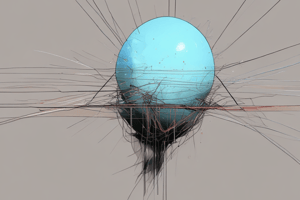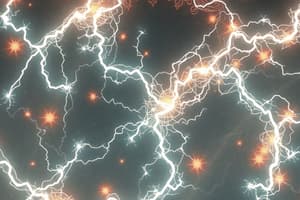Podcast
Questions and Answers
What occurs to the materials involved in frictional charging when they are rubbed together?
What occurs to the materials involved in frictional charging when they are rubbed together?
- Both materials become negatively charged.
- Both materials become neutral.
- One material loses electrons while the other gains electrons. (correct)
- Electrons are created in one of the materials.
Which material would most likely gain electrons when in contact with rubber?
Which material would most likely gain electrons when in contact with rubber?
- Wool (correct)
- Metal
- Plastic
- Wood
Why do clothes in a dryer sometimes stick together?
Why do clothes in a dryer sometimes stick together?
- Friction transfers electrons, creating static charge. (correct)
- They generate heat which causes them to bond.
- They gain a positive charge from the dryer.
- They become magnetized due to motion.
What is the primary difference between conduction and frictional charging?
What is the primary difference between conduction and frictional charging?
In conduction, what happens to the charges of the charged and neutral objects upon contact?
In conduction, what happens to the charges of the charged and neutral objects upon contact?
Which of the following materials is an insulator and does not allow charge to flow easily?
Which of the following materials is an insulator and does not allow charge to flow easily?
What charge does a balloon acquire when rubbed against hair?
What charge does a balloon acquire when rubbed against hair?
Which scenario exemplifies electrification by conduction?
Which scenario exemplifies electrification by conduction?
What occurs when a charged object influences a neutral object without direct contact?
What occurs when a charged object influences a neutral object without direct contact?
What is required for conduction to occur between two objects?
What is required for conduction to occur between two objects?
How does charge redistribution occur in induction?
How does charge redistribution occur in induction?
What happens to the charges in a neutral object when a negatively charged balloon is brought near it?
What happens to the charges in a neutral object when a negatively charged balloon is brought near it?
What defines the effectiveness of charge transfer during conduction?
What defines the effectiveness of charge transfer during conduction?
What is a key characteristic of static electricity caused by friction?
What is a key characteristic of static electricity caused by friction?
What is true about the induced charge in a neutral object during induction?
What is true about the induced charge in a neutral object during induction?
Which of the following situations best illustrates the concept of conduction?
Which of the following situations best illustrates the concept of conduction?
Which factor does NOT affect the amount of charge transferred during conduction?
Which factor does NOT affect the amount of charge transferred during conduction?
In which of the following scenarios would static electricity pose a risk?
In which of the following scenarios would static electricity pose a risk?
Flashcards
Static Electricity (Friction)
Static Electricity (Friction)
Electricity generated when two different materials are rubbed together, causing electrons to transfer.
Electron Transfer
Electron Transfer
Movement of electrons from one material to another during friction.
Charging by Friction
Charging by Friction
Process of creating static electricity through rubbing
Positively Charged
Positively Charged
Signup and view all the flashcards
Negatively Charged
Negatively Charged
Signup and view all the flashcards
Conduction (Contact)
Conduction (Contact)
Signup and view all the flashcards
Conductors
Conductors
Signup and view all the flashcards
Insulators
Insulators
Signup and view all the flashcards
Static Electricity: Conduction
Static Electricity: Conduction
Signup and view all the flashcards
Static Electricity: Induction
Static Electricity: Induction
Signup and view all the flashcards
Conductor (Static Electricity)
Conductor (Static Electricity)
Signup and view all the flashcards
Insulator (Static Electricity)
Insulator (Static Electricity)
Signup and view all the flashcards
Direct Contact (Static Electricity)
Direct Contact (Static Electricity)
Signup and view all the flashcards
Charge Transfer
Charge Transfer
Signup and view all the flashcards
Electric Field
Electric Field
Signup and view all the flashcards
Induced Charge
Induced Charge
Signup and view all the flashcards
Friction (Static Electricity)
Friction (Static Electricity)
Signup and view all the flashcards
Static Electricity
Static Electricity
Signup and view all the flashcards
Study Notes
Static Electricity: Friction, Conduction, and Induction
- Friction: Static electricity generated by rubbing two different materials together. Electrons transfer from one material to the other, creating a charge imbalance. The material losing electrons becomes positive, and the material gaining electrons becomes negative. Common materials involved include wool, plastic, and rubber. This method relies on a material's tendency to hold onto electrons.
Static Electricity: Conduction
- Conduction: Static electricity transferred through direct contact. When a charged object touches a neutral object, electrons move between them until both objects reach equilibrium (balance).
- Conductor vs. Insulator: Conductors (e.g., metals) allow electrons to move freely, aiding charge transfer. Insulators (e.g., rubber) impede electron flow, reducing charge transfer.
- Examples: Touching a metal doorknob after walking on a carpet, or charging a metal rod with a charged rubber rod.
Static Electricity: Induction
- Induction: Creating static electricity without direct contact. A charged object influences the distribution of charges in a nearby neutral object; this creates temporary opposite charges.
- No Contact Required: The electric field of the charged object causes redistribution of electrons without physical touch.
- Temporary Charges: Induced charges are temporary and disappear when the charged object is moved.
- Examples: Bringing a charged balloon near a wall; inducing charges in a metal object with a charged rod.
Summary Comparison of Methods
| Method | How it Works | Key Characteristics | Example |
|---|---|---|---|
| Friction | Rubbing causes electron transfer | Requires two different materials; charge imbalance | Rubbing a balloon on hair |
| Conduction | Direct contact transfers charge | Charge flows directly; conductors work best | Touching a metal doorknob after walking on carpet |
| Induction | Electric field influences charge distribution | No contact needed; temporary charges | Bringing a charged balloon near a wall |
- Electric Fields: Electric fields are crucial in both induction and friction. Charged objects create fields that influence other objects.
- Safety: Static electricity can be dangerous in flammable environments due to the risk of sparks igniting gases or vapors.
Studying That Suits You
Use AI to generate personalized quizzes and flashcards to suit your learning preferences.
Description
This quiz covers the fundamentals of static electricity, focusing on friction and conduction. Understand how static charge is generated and transferred through different materials. Test your knowledge about conductors, insulators, and the practical examples of static electricity in everyday life.




